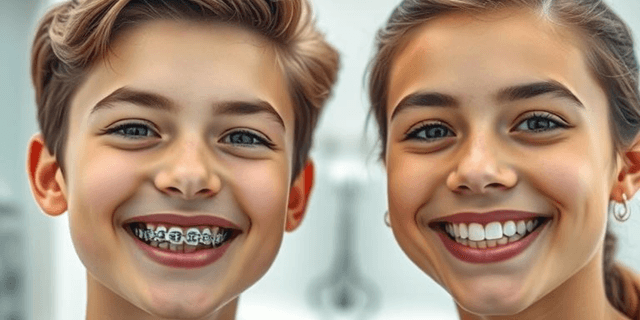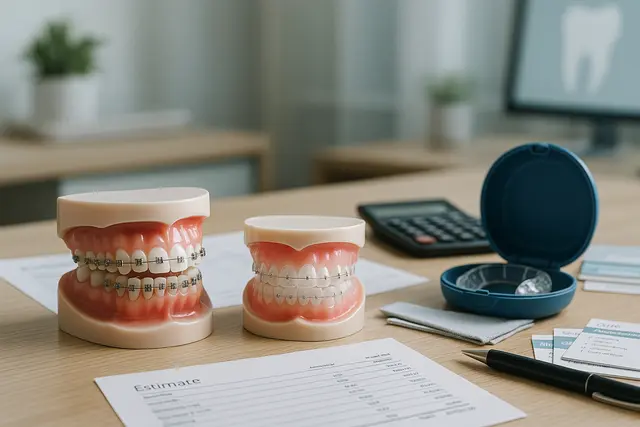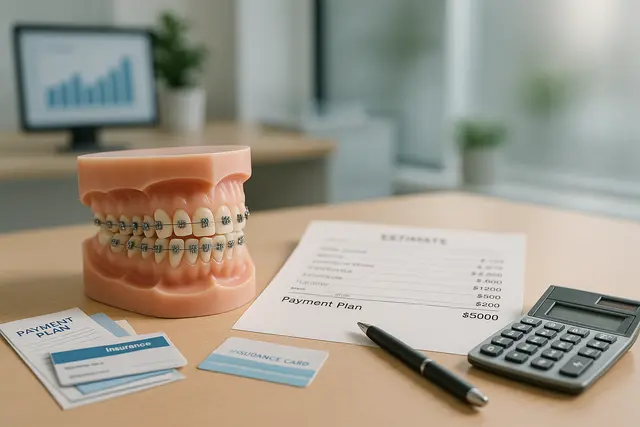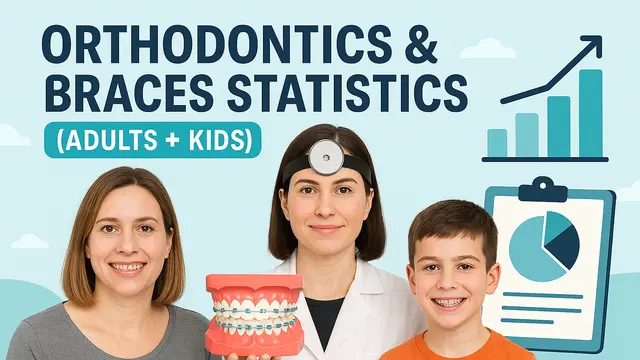Orthodontics
5 min read
Apr 03, 2025
Traditional Metal Braces vs. Modern Alternatives: Which Is Right for You?
Braces have become almost synonymous with orthodontics, but the choices available today go well beyond what many remember from childhood. Whether you're dealing with crowding, misalignment, or a bite issue, orthodontic treatment can improve both oral health and appearance. And while metal braces are still widely used, alternatives like clear aligners and ceramic braces have expanded what's possible in terms of comfort, aesthetics, and lifestyle compatibility.

Ever caught yourself hiding a laugh because your teeth aren’t quite lined up the way you’d like? You’re not alone. Whether you’re dealing with crowded teeth, an overbite, or just want a straighter smile, today’s orthodontic world has more options than ever. And no, it’s not just the shiny silver train tracks we all remember from middle school. From traditional braces to sleek clear aligners, there’s a treatment to match every lifestyle, and every level of misalignment.
Let’s break it down so you can make the most confident choice for your teeth, your comfort, and your day-to-day life.
Why Traditional Metal Braces Are Still Going Strong
When people think of braces, they usually picture metal brackets and wires, and there’s a reason for that. Traditional metal braces have been straightening teeth for generations. They consist of metal brackets bonded to your teeth, connected by metal wires that your orthodontist adjusts to gradually shift teeth into the desired position.
Despite all the newer alternatives, traditional braces are still the go-to for correcting serious dental issues like bite problems or severe crowding. They’re always on the job, working 24/7 to shift teeth into alignment. And let’s be honest: while they’re more visible than other options, today’s versions are smaller, smoother, and a lot more comfortable than they used to be.
The Benefits of Choosing Traditional Braces
Here’s why traditional braces may be the right fit for you:
They’re powerful. Braces can address a wide range of orthodontic concerns, even the tough ones.
They’re reliable. Because they’re fixed in place, there’s no forgetting to wear them, consistency is built in.
They’re affordable. Metal braces use strong materials that are often more budget-friendly than newer alternatives.
For some, there’s even a fun side: elastic color bands let you show off a bit of personality at each appointment.
Clear Aligners: The Nearly Invisible Option
If you're looking for something low-key, clear aligners are ideal. Invisalign is the most recognized name, but there are many clear aligner options on the market now. These trays are custom-made, removable, and nearly invisible when worn. You’ll switch to a new set every couple of weeks as your teeth gradually shift.
Because clear aligners are removable, keeping up with oral hygiene is much easier than with brackets and wires. You can brush and floss like normal, no need for special tools or workarounds.
How Clear Aligners Work and Who They’re Best For
Each set of clear aligners moves your teeth slightly closer to their final positions. A full treatment plan can include 20–30 sets or more, depending on how complex your case is.
Clear aligners offer:
A discreet look: Most people won’t even notice you’re wearing them.
Convenient care: Eat what you want, clean your teeth normally.
Custom-fit comfort: Each aligner is made just for your teeth.
But keep in mind, clear aligners work best when worn 22 hours a day. If you’re someone who might forget to pop them back in, this orthodontic solution might not be the best fit.
Ceramic Braces: Less Metal, More Subtlety
Ceramic braces work similarly to traditional ones but use clear or tooth-colored brackets that blend in with your teeth. They’re a great option if you want something that’s less noticeable but still powerful.
These braces can be slightly more fragile than metal ones, and they may stain if not cleaned properly. Still, ceramic braces might be a nice middle ground between appearance and performance.
Lingual Braces: Braces That Hide Behind Your Teeth
Lingual braces are like traditional braces, but with a twist. The brackets and wires are placed on the back side of your teeth, facing your tongue. This makes them practically invisible from the front.
They’re popular among adults and professionals who want a completely hidden way to straighten teeth, but they can be more difficult to clean and may affect your speech at first.
Self-Ligating Braces: A Modern Spin on Metal
Self-ligating braces are a newer version of traditional metal braces. Instead of using colored elastics to hold the wires in place, they use special clips. These reduce friction and can make adjustments quicker and more comfortable.
You’ll still have brackets and wires, but some patients say they feel smoother and may require fewer visits to the orthodontist.
Comparing Your Braces Options Side by Side
There are lots of orthodontic options to help straighten your teeth, and each comes with its own pros and cons. Here’s a quick snapshot:
Treatment Type | Visibility | Removable | Best For |
Traditional Metal Braces | High | No | Complex dental issues |
Clear Aligners | Very low | Yes | Mild to moderate misalignment |
Ceramic Braces | Medium | No | Aesthetic-conscious teens/adults |
Lingual Braces | Very low (hidden) | No | Professionals, performers |
Self-Ligating Braces | Medium to high | No | Faster adjustments, less friction |
What to Expect After Braces: Don’t Skip the Retainer
No matter which type of braces you choose, your orthodontic treatment isn’t over when the braces come off or the last aligner is tossed. You’ll need to wear a retainer to keep those newly straightened teeth in place. Without one, they’ll start to shift right back, and nobody wants a smile that reverts after all that hard work.
Retainers can be removable or fixed, and your orthodontist will recommend the best type for your smile.
Choosing the Right Treatment for Your Smile
So, choosing between traditional braces and modern alternatives really comes down to what matters most to you. Do you want the most effective treatment for a complicated case? Traditional braces may win out. Do you want something discreet that fits into a busy lifestyle? Clear aligners or lingual braces might be the better fit.
Think about:
Your daily habits
Your budget
The severity of your misalignment
Your comfort with visible hardware
And don’t make the decision alone, an experienced orthodontist or dentist can evaluate your needs and walk you through all the braces and alternatives available.
Final Thoughts: There’s No One-Size-Fits-All Smile Fix
Modern orthodontic options are better than ever. Whether you go with traditional braces with modern updates, clear aligners that slip in and out with ease, or something in between, there’s an orthodontic solution out there that fits your lifestyle. The key is finding the treatment option that works for you, your goals, and your schedule.
Straighten your teeth not just to look good, but to feel good when you flash your smile. With so many braces available today, you really can find the perfect treatment for your smile, and enjoy the process along the way.
What Are the Main Types of Braces Available Today?
Today’s orthodontic options include traditional metal braces, ceramic braces, lingual braces, self-ligating braces, and clear aligners. Each offers unique benefits in terms of appearance, comfort, cost, and how they handle various levels of misalignment.
Are Clear Aligners As Effective As Traditional Braces?
Clear aligners are effective for mild to moderate alignment issues but may not be suitable for complex cases. Traditional braces are fixed and work continuously, making them better suited for more severe bite or crowding problems.
What’s the Most Discreet Option for Straightening Teeth?
Clear aligners and lingual braces are the most discreet. Aligners are nearly invisible and removable, while lingual braces hide behind the teeth. Both are popular with adults and professionals seeking a less noticeable solution.
Will I Need a Retainer After Treatment?
Yes. No matter which orthodontic method you choose, a retainer is essential to maintain your results. Without one, your teeth can shift back over time. Retainers may be removable or fixed, depending on your orthodontist’s recommendation.
Read Next
Related Posts

Orthodontics
Retainer That Looks like Braces: Benefits for Long-Term Alignment
A retainer might not get as much attention as braces, but it plays a crucial role in maintaining your smile after orthodontic treatment. Whether you're new to retainers or curious about the type that looks like braces, understanding their purpose and benefits is key to keeping your teeth aligned for the long haul.
6 min read
Sep 15, 2025

Orthodontics
How Much Are Metal Braces? Cost Comparison With Other Options
Thinking about getting braces but overwhelmed by the cost? You’re not alone. Orthodontic treatment can be a major investment, and understanding the different price points, from metal braces to clear aligners, can help you make a smart, confident decision.
5 min read
Sep 15, 2025

Orthodontics
Orthodontics & Braces Statistics (Adults + Kids)
Orthodontics has transformed from a niche medical service for teenagers into a booming sector that spans all ages. Today, both adults and children seek orthodontic treatment to improve their smiles, fix bite issues, and boost self-confidence.
4 min read
Aug 21, 2025
Don’t have time to research every dentist around you?
See why 30k+ patients trusted us